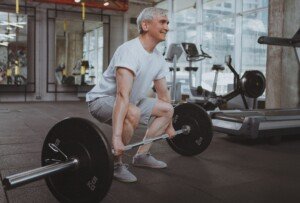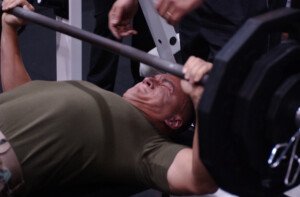Confused over those general weightlifting guidelines for Da Vinci surgery? What exactly does “heavy” mean after a prostatectomy?
If you’ve just had a prostatectomy or robotic surgery to treat prostate cancer, you’ll be told to take it easy for a while following the procedure.
What if previous to the operation, you had a routine of lifting weights?
Or, what if you’d like to take up weightlifting for the first time?
The problem with generalized instructions is that they’re open to subjective interpretation.
For instance, It’s very easy to pick a 20 lb. box off the floor to move it five feet to another area of the floor.
But it’s more stressful on the body to raise that same item overhead and put it on a high shelf.
Or, it’s more strenuous to reach into the backseat of your car to lift that 20 pounds out, vs. simply lifting it a few inches off the floor and setting it aside.
Have you read guidelines saying to lift only at 50 percent capacity? This, too, is open to interpretation.
Suppose prior to your prostatectomy you were deadlifting 250 pounds for repetitions. Half that is 125 pounds: a walk in the park.
But to another man, perhaps an older one who’s never weight trained before, 125 pounds will be quite heavy.

Shutterstock/ Ihor Bulyhin
Thus, 125 pounds is out of the question for him, but perfectly fine for the aforementioned individual who already has a trained body.
Getting Specific About Strength Training Guidelines Following Da Vinci Surgery or a Prostatectomy
Let’s first begin with the basics immediately following the procedure.
“During the first two weeks after discharge, you should gradually increase your activity level,” says Kiarash Michel, MD, a urologic oncological surgeon with Cedars Sinai who specializes in robotic surgery, and is cofounder of MDbio, a plant-based medicine company.
“After a couple of days, getting out of the house is important because it allows you to get some fresh air and straighten your legs.
“Do not lie down or sit in a chair for long periods of time. But if something hurts you, don’t do it! It’s a sign of your body that needs to be respected.
“Avoid heavy lifting, as this can lead to DVT.” A DVT is a deep vein thrombosis.
Usually it forms in the lower leg, and sometimes it causes symptoms (redness, warmth in a specific area such as the calf, swelling, pain or cramping).
This blood clot can break apart and within moments, end up in a lung, causing difficulty with breathing and/or chest pain.
Worse, if the clot is big enough, it could get stuck or “saddled” right where the pulmonary artery splits into each lung, instantly completely blocking oxygen to both lungs: a fatal condition.
What exactly does “heavy” weightlifting mean?
Dr. Michel explains, “You may define heavy lifting as anything which would have been ‘heavy’ for you before surgery.”
So if you found bench pressing 155 pounds difficult, you must avoid this, even though this is a warmup weight for many other men.
Even if 95 pounds was challenging, it’s the challenge that’s the issue, not the weight of the bar.
“That said, what’s just as important as the weight you lift is how you lift it.
“Doing exercises that cause you to ‘bear down’ while you are still recovering from your surgery could have negative consequences.”
Bearing down refers to a feeling that you must strain to lift, press or pull the weight load.
This sensation makes you want to grunt, even if you don’t actually do it.
It may make it difficult to hold a straight face rather than grimace and squint your eyes.

His face shows that the barbell is too heavy during a prostatectomy recovery.
It might make you feel similar to how you feel when pushing out a difficult bowel movement.
Regardless of the amount of weight—you should not lift an amount that makes you feel any such way.
This applies to any weightlifting move such as an incline dumbbell press, T-bar row or hack squat.
A good, clear guideline is to stick to your warmup loads; let your warmup amounts be your “working sets.”
During your recovery from a prostatectomy, you should not be straining or fighting to complete a set.
The set should have a medium or light feel to it, not a strenuous or intense feel.
Keep your surgeon informed so that they can guide you with gradual progression into heavier weights or towards your pre-procedure loads.
“Ultimately, you are the one who is most familiar with your body’s limits,” says Dr. Michel.
“If you are very physically active, it is likely that you can return to physical activity and get back to lifting weights a little sooner than the average patient.”
Again, you should discuss with your doctor just what “soon” means for your body.
The discussion should include examples of strength training moves (e.g., leg press, squat, bent-over barbell row).
“Use common sense and, above all, talk with your doctor about your particular limits.”
 Dr. Michel is a leading physician in prostate cancer therapy, urological cancers, benign prostatic hyperplasia, female urology, urinary disorders, incontinence, erectile dysfunction, stone diseases and anti-aging. MDbio provides safe non-pharmaceutical alternatives to maximizing overall health and wellbeing.
Dr. Michel is a leading physician in prostate cancer therapy, urological cancers, benign prostatic hyperplasia, female urology, urinary disorders, incontinence, erectile dysfunction, stone diseases and anti-aging. MDbio provides safe non-pharmaceutical alternatives to maximizing overall health and wellbeing.
 Lorra Garrick has been covering medical, fitness and cybersecurity topics for many years, having written thousands of articles for print magazines and websites, including as a ghostwriter. She’s also a former ACE-certified personal trainer.
Lorra Garrick has been covering medical, fitness and cybersecurity topics for many years, having written thousands of articles for print magazines and websites, including as a ghostwriter. She’s also a former ACE-certified personal trainer.
.










































